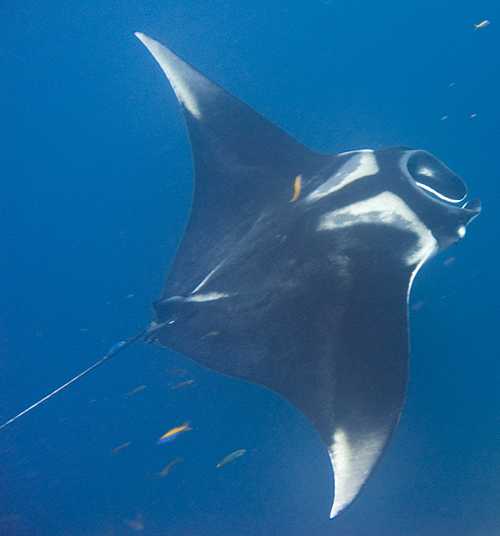 Giant Manta Ray Giant Manta RayManta
birostris; "manta" is from a
Spanish word meaning blanket
Description
The largest member of the ray family, the
giant manta is up to 22 feet across and weighs up
to 3,500 pounds. Aside from its size, it can be
distinguished from other rays by its large
triangular pectoral "wings" and
paddle-like lobes extending in front of the
mouth. There are no caudal fins, and a small
dorsal fin. It has a short, whip-like tail that,
unlike many rays, has no sharp barb. The eyes are
on the sides of the head, and the gills are on
the underside of the body.
Manta rays vary in color from black to grayish
blue along the back, and have a white underside
with grayish blotchs that have been used to
identify individual rays. There are also large
white "shoulder patches" on the back
that are usually triangular- or chevon-shaped,
and there may also be white patches on the tips
of the pectoral fins.
Distribution and
Habitat
Manta rays are found in
tropical, sub-tropical, and temperate waters
worldwide. They tend to stay stay closer to shore
in the warmer waters where food is more abundant,
but can be found in the open ocean. Although
capable of diving to depths of over 3,000 feet,
they spend most of their time at depths of less
than 390 feet.
Manta rays are highly
migratory, and commonly travel across thousands
of miles of open ocean in search of food sources.
Diet
Manta rays filter water through their gills
and organisms in the water are trapped by a
filtering device, which consists of plates in the
back of the mouth that are made of pinkish-brown
tissue that span between the support structures
of the gills. Plankton make up the vast majority
of the diet, but small fish and crustaceans are
also taken. The manta's teeth serve no function
during feeding.
Reproduction
Courtship can last for days,
with several males following a single female,
competing for the right to mate. Eggs are
fertilized and develop internally, with one or
two pups being born after about twelve months.
Pups are able to fend for
themselves almost immediately, and may double in
size within their first year. Sexual maturity is
reached at about five years, and average lifespan
in the wild is over forty years.
Behavior
Manta rays are generally
solitary, but loose groups will form where there
is abundant food, as well as for mating.
Manta rays can leap up to seven
feet out of the water. Whether this is done for
fun, to get rid of skin parasites, or both, is
unknown.
Although they are generally
leisurely swimmers, especially when feeding,
manta rays are capable of achieving great speed.
Scientific
Classification
phylum Chordata
subphylum Vertebrata
class Chondrichthyes
order Rajiformes
family Mobulidae
genus & species Manta birostris
Questions or comments about
this page?
|



